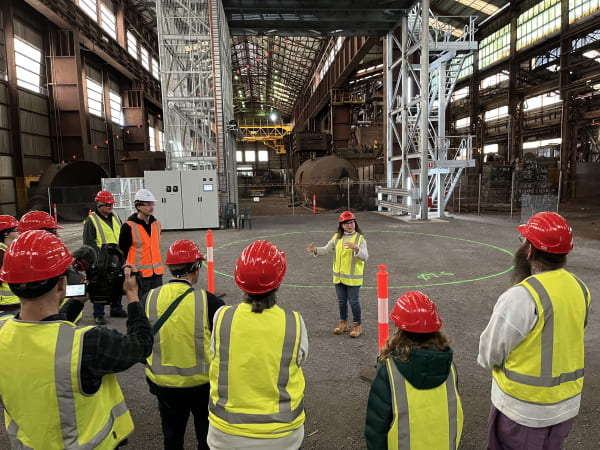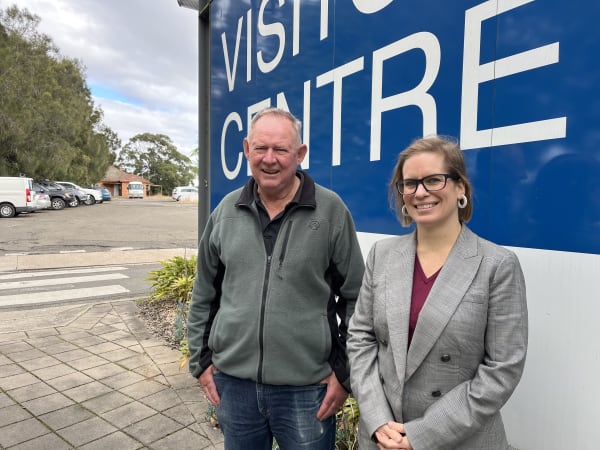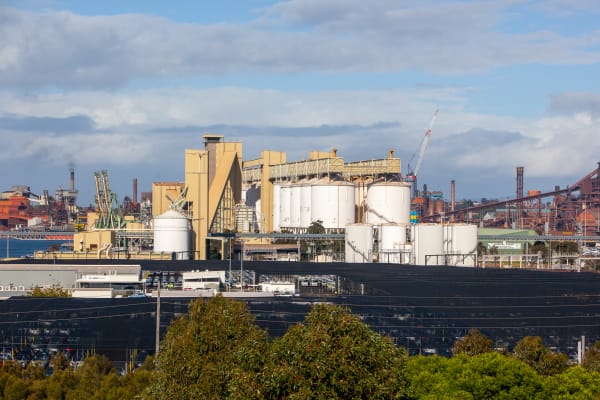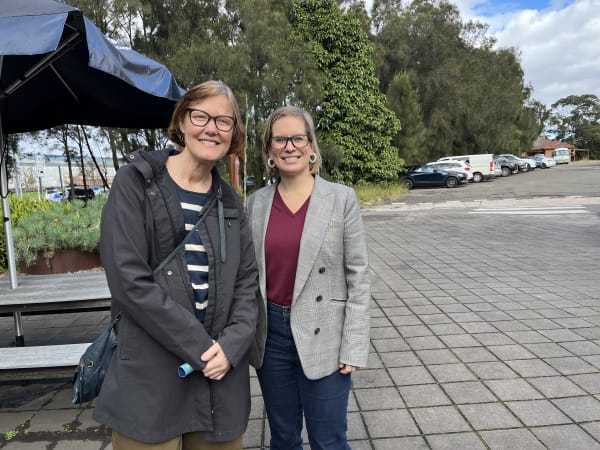On July 3, Hi Neighbour volunteer Darryl Best organised a special tour of Port Kembla and the steelworks to welcome a clean economy celebrity to Wollongong.
Afterwards, Heidi Lee, the Melbourne-based CEO of independent think tank Beyond Zero Emissions, said she saw “so much talent and potential” in the Illawarra.
“You’ve got incredible industrial infrastructure here,” Heidi said.
“You've got trains and the port, and you've got this workforce. You've got all of the existing supply chain …
“I think we need to see more innovation being commercialised – you’ve got a fantastic university here. You've got training facilities, but we have to commercialise technologies like what we saw today; we drove past Hysata, we saw Green Gravity.”

Innovation in action at Gravity Lab
The tour’s highlight was a look inside Green Gravity’s ‘Gravity Lab’, an old industrial warehouse where an innovative, at-scale experiment in green energy storage is taking place.
Green Gravity aims to repurpose old mines with new technology, by lifting and lowering heavy weights inside mine shafts to capture and release gravitational energy. Tania Jones, manager of sustainable market development at Green Gravity, told the tour group that converting the shuttered coal mine at Russell Vale, for example, could service the overnight energy needs of a few surrounding suburbs,
Heidi said diversity in battery generation and storage is needed in a clean economy. “When they can get commercial, products like Green Gravity are going to be so important for providing that medium to long-term energy storage.
“The high-density batteries, like lithium and others, will do really well at meeting these household energy storage requirements. They're going to be great for cars, mid-size vehicles, but we really need to be looking to these alternatives – like hydro and gravity and vanadium [a strong, durable metal] and others – that provide that medium- to long-term energy storage.”

Insights into industry
Darryl Best, a retired coal miner turned renewable jobs advocate, invited a mix of industry, sustainability and climate advocates to join the tour, which also took in the CoreGas Hydrogen depot, Australia’s first hydrogen refuelling station for trucks and buses.
It was a tailored version of BlueScope’s popular ‘Inside Industry’ tours for the public that run on the third Saturday of each month.
The guides are retired steelworkers, who share their own memories of Wollongong’s heyday as a Steel City employing more than 20,000 people, a time when the steelworks was a city unto itself. Today, the workforce has been reduced to about 3000, plus contractors, and steel is made primarily for the Australian market. Access to clean energy to make green steel could be vital for its survival.
Heidi gave the experience a five-star review. “I thought this was a fantastic tour. I love that we were getting blown off the waterfront. It’s a really great example of just how much wind potential there is here – offshore wind is going to be absolutely critical to being able to keep the local industries, like the ones that we heard about today, alive.
“When their business model requires them to be zero carbon, or low emissions, they are going to need every green molecule they can get.”
Heidi believes offshore energy is important here, as land space is constrained by nature and escarpment in the west. “We really need to look out to the east [to the ocean], to make sure that we can keep our industries alive,” she said.
Different views, shared values
The possibility of offshore wind has been particularly divisive in the Illawarra, with people for and against stepping off social media to form community associations Good for the Gong and Responsible Future. Yet amid the controversy, Heidi sees common ground.
"There's a huge amount of misinformation and disinformation about what the change of brown and black and gray electrons to green electrons is actually going to mean," she said.
"I think there are a lot of really important values that are shared across the debate. And it's really important for us to understand that… this binary – should we or should we not have offshore wind? Or should we or should we not have solar farms? – it's a false binary, it really is.
"We are coming together because of things we share a lot of care for. And that's things like, we all want to have a great community. We want to have jobs for our kids. We want to have our nature and beautiful cultural heritage protected.
"And that's a shared value. That's not something that we need to fight about."
While people have different ideas about the impacts of the respective choices, Heidi said that doing nothing is not an option. "It's a terrible option. We have to do something.
"The vast majority of people are not bad faith actors. They really care about our coastlines, our natural heritage, it's worth protecting. And we all care very deeply about these places all across Australia, and we are not very well informed about the cost of doing nothing – the terrible cost to everything we care about of doing nothing."
It's a pivotal time for Wollongong, and the world, she believes. "We can move over to renewables and be able to do wonderful things in our community with all that green energy."

Opportunities ahead for the Illawarra
Part of Heidi’s role at Beyond Zero Emissions involves taking big national ideas about the shift to renewables and showing how regional communities can prosper in real, practical ways.
“Understanding what's going on in local businesses is absolutely critical because this is where you move the conversation from thinking that this is going to be an enormous change, and we've got to throw everything out and start again, and you realise that there's so much already happening.”
The Illawarra has a key role in the national race to decarbonise and Port Kembla is an important renewable energy industrial precinct, Heidi said.
“In terms of, how is Wollongong going? I think it's like right up there with one of the top highest potential places around Australia – but that depends on getting the green electrons in to support those industries to decarbonise and grow; being able to make sure that we're investing in these pre-commercial ventures to get them over into that commercial category; and just capitalising on the opportunity of all the steel workers and the fossil fuel industry workers, because this is an asset.”



